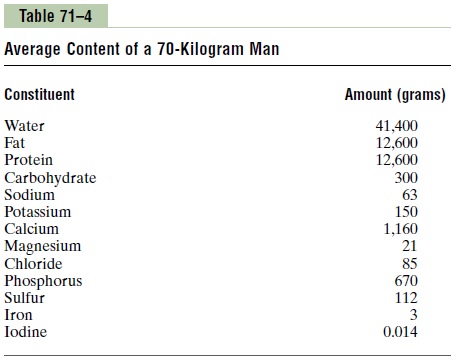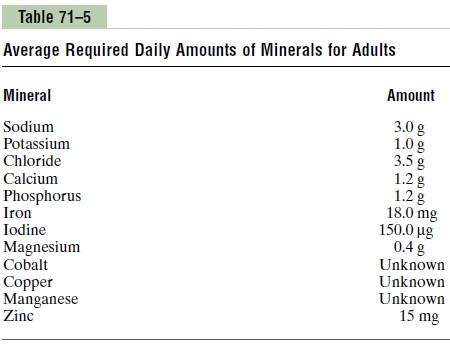Chapter: Medical Physiology: Dietary Balances; Regulation of Feeding; Obesity and Starvation; Vitamins and Minerals
Mineral Metabolism
Mineral Metabolism
The functions of many of the minerals, such as sodium, potassium, and chloride, are presented at appropriate points in the text. Only specific functions of minerals not covered elsewhere are mentioned here. The body content of the most important minerals is listed in Table 71–4, and the daily requirements of these are given in Table 71–5.

Magnesium. Magnesium is about one sixth as plentiful incells as potassium. Magnesium is required as a catalyst for many intracellular enzymatic reactions, particularly those related to carbohydrate metabolism.
The extracellular fluid magnesium concentration is slight, only 1.8 to 2.5 mEq/L. Increased extracellular concentration of magnesium depresses nervous system activity as well as skeletal muscle contraction.This latter effect can be blocked by the administration of calcium. Low magnesium concentration causes increased irri-tability of the nervous system, peripheral vasodilation, and cardiac arrhythmias, especially after acute myocar-dial infarction.

Calcium. Calcium is present in the body mainly in theform of calcium phosphate in the bone. Excess quantities of calcium ions in extracellular fluid can cause the heart to stop in systole and can act as a mental depressant. At the other extreme, low levels of calcium can cause spon-taneous discharge of nerve fibers, resulting in tetany.
Phosphorus. Phosphate is the major anion of intracellularfluid. Phosphates have the ability to combine reversiblywith many coenzyme systems and with multiple other compounds that are necessary for the operation of metabolic processes. Many important reactions of phos-phates have been catalogued at other points in this text, especially in relation to the functions of adenosine triphosphate, adenosine diphosphate, phosphocreatine, and so forth. Also, bone contains a tremendous amount of calcium phosphate.
Iron. The function of iron in the body, especially in rela-tion to the formation of hemoglobin.. Two thirds of the iron in the body is in theform of hemoglobin, although smaller quantities arepresent in other forms, especially in the liver and the bone marrow. Electron carriers containing iron (espe-cially the cytochromes) are present in the mitochondria of all cells of the body and are essential for most of the oxidation that occurs in the cells. Therefore, iron is absolutely essential for both the transport of oxygen to the tissues and the operation of oxidative systems within the tissue cells, without which life would cease within a few seconds.
Important Trace Elements in the Body. A few elements arepresent in the body in such small quantities that they are called trace elements. The amounts of these elements in foods are also usually minute. Yet without any one of them, a specific deficiency syndrome is likely to develop. Three of the most important are iodine, zinc, and fluorine.
Iodine. The best known of the trace elements is iodine. This element is discussed in connection with the formation and function of thyroid hormone; as shown in Table 71–4, the entire body contains an average of only 14 milligrams. Iodine is essential for the formation of thyroxine and triiodothyronine, the two thyroid hormones that are essential for maintenance of normal metabolic rates in all cells of the body.
Zinc. Zinc is an integral part of many enzymes, one ofthe most important of which is carbonic anhydrase, present in especially high concentration in the red blood cells. This enzyme is responsible for rapid combination of carbon dioxide with water in the red blood cells of the peripheral capillary blood and for rapid release of carbon dioxide from the pulmonary capillary blood into the alveoli. Carbonic anhydrase is also present to a major extent in the gastrointestinal mucosa, the tubules of the kidney, and the epithelial cells of many glands of the body. Consequently, zinc in small quantities is essen-tial for the performance of many reactions related to carbon dioxide metabolism.
Zinc is also a component of lactic dehydrogenase and is therefore important for the interconversions between pyruvic acid and lactic acid. Finally, zinc is a component of some peptidases and is important for the digestion of proteins in the gastrointestinal tract.
Fluorine. Fluorine does not seem to be a necessaryelement for metabolism, but the presence of a small quantity of fluorine in the body during the period of life when the teeth are being formed subsequently protects against caries. Fluorine does not make the teeth them-selves stronger but has a poorly understood effect in suppressing the cariogenic process. It has been sug-gested that fluorine is deposited in the hydroxyapatite crystals of the tooth enamel and combines with and therefore blocks the functions of various trace metals that are necessary for activation of the bacterial enzymes that cause caries. Therefore, when fluorine is present, the enzymes remain inactive and cause no caries.
Excessive intake of fluorine causes fluorosis, which manifests in its mild state by mottled teeth and in its more severe state by enlarged bones. It has been pos-tulated that in this condition, fluorine combines with trace metals in some of the metabolic enzymes, includ-ing the phosphatases, so that various metabolic systems become partially inactivated. According to this theory, the mottled teeth and enlarged bones are due to ab-normal enzyme systems in the odontoblasts and osteoblasts. Even though the mottled teeth are highly resistant to the development of caries, the structural strength of these teeth may be considerably lessened by the mottling process.
Related Topics